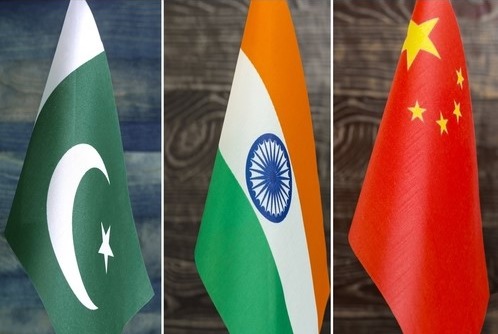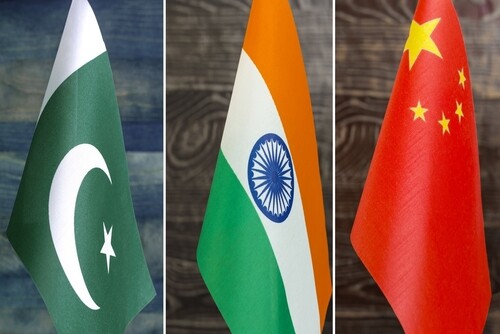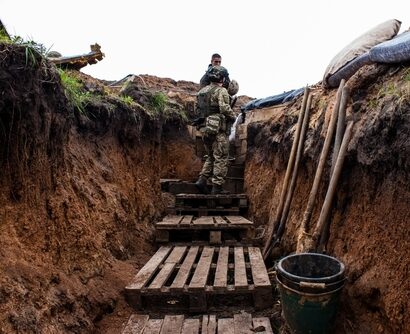Abstract: This year will mark 25 years of nuclearization in Southern Asia. This silver jubilee arrives at a critical juncture, one in which the region faces significant turbulence. Geopolitics has certainly changed over the course of more than two decades. That said, new dimensions of strategic competition have emerged in the region, leading to several dynamic shifts in the nuclear policies of the Nuclear Weapons State in the region. This paper intends to cover the 25 years’ journey of Nuclear Southern Asia and what the likely future(s) could entail, considering the current geopolitical context.
Problem statement: How does the current geopolitical rivalry affect nuclear stability in Southern Asia?
Bottom-line-up-front: Moving 25 years forward today, Southern Asian nuclear dynamics have taken a leap in a multifaceted manner. Over the course of 25 years, there has been significant development in terms of nuclear strategy, posture, threat perception, and, most importantly, nuclear doctrine made by all three regional nuclear powers – India, China and Pakistan. Nuclear competition is likely to exist in the region.
So what?: The region needs a revival of old bilateral mechanisms and the establishment of new multilateral mechanisms like Confidence Building Measures (CBM) if the aversion of a nuclear war is a goal. To assume an unrealistic stance, that is, the expectation of resolving all regional disputes is not possible. Rather, a realistic goal of making the region safer from the risk of nuclear war must be a top priority and, as such, take precedence even more so as the region stands at a critical point today.

Source: shutterstock.com/nau2018
A Nuclear South Asia
Southern Asia completes 25 years of nuclearization this year. The silver jubilee of a nuclearised Southern Asia comes at a critical juncture when the region faces significant turbulence. Countries in the region are experiencing several internal challenges, including political instability, economic crisis, and social unrest. Regionalism seems to be at a crossroads. Bilateral relations between countries in the region are limited, further complicating efforts to address these internal challenges. Cross-border terrorism and frequent border clashes between the armed forces have infused a general deficit in trust regarding the region. Additionally, the rise of China as a global superpower poses significant implications for the region. Home to the three youngest and geographically closest nuclear neighbours, South Asia is now in the midst of a superpower rivalry in the Indo-Pacific region too. It is therefore important to assess the regional nuclear dynamics, starting by looking into its past, where it stands today and the probable future of nuclear southern Asia.
The rise of China as a global superpower poses significant implications for the region. Home to the three youngest and geographically closest nuclear neighbours, South Asia is now in the midst of a superpower rivalry in the Indo-Pacific region.
History of an Organic Rivalry
The two nuclear powers in the region, India and Pakistan, weaponized nuclear technology primarily to mitigate the existential threat to its survival after each conducted nuclear tests in May 1998, one after the other.[1] The immediate reasons for the tests may have been reactionary. Still, the larger aspirations for nuclear weapons for both India and Pakistan remain largely rooted in their intense geopolitical rivalry against one another. Pakistan’s quest for a nuclear arsenal was largely driven by the eventual realization of conventional military disparity against its arch-rival, India. What was etched in the memories of successive military leaders of Pakistan was the loss of the eastern sector in the 1971 war with India.[2] In the spring of 1972, Pakistani leader Zulfikar Ali Bhutto gave the nod for nuclear weapons.[3]
Contesting the largely argued idea (by many) that the dismemberment of Pakistan in the 1971 war was the motivation for its quest for nuclear weapons, scholars like Christine Fair have argued that it began its quest for nuclear weapons soon after the India-China war of 1962 and China’s detonation of its nuclear devices in 1964.[4] Despite several well-reasoned assessments of Pakistan’s motivation, India’s centrality was omnipresent behind Pakistan’s nuclear weapons.
Considering the Indo-China War of 1962, which came as a shock to India, nuclear aspirations were not just restricted to Pakistan. Chinese assistance in arming Pakistan was an additional cause of concern given that India’s relations with Pakistan were strained and South Asian geopolitics were under immense stress. The prevalent narrative surrounding India’s nuclear program – that it built nuclear weapons in reaction to China’s – does not make sense without highlighting India’s own ambition to become a superpower, in China’s opinion.[5] China also holds that in the context of its interactions with other international actors like Pakistan and the United States, India’s domestic politics have always been crucial in deciding the country’s policy options.[6]
The prevalent narrative surrounding India’s nuclear program does not make sense without highlighting India’s own ambition to become a superpower, in China’s opinion.
While South Asian nuclear dynamics remained largely restricted to understanding India and Pakistan’s nuclear behaviour in the region, the impact of China’s influence on the nuclear dynamics has never remained out of the question. Since the early inception of the India-Pakistan rivalry, China has played a major role in influencing nuclear behaviour in the region and continues to do so. This is reflected in several reports by analysts who have continued to study the regional nuclear dynamics, including China as part of Nuclear Southern Asia due to cascading effect of China’s competition with powers outside South Asia.[7] Despite China’s continuous insistence on no direct nuclear competition with India or Pakistan, its strategic interests and alliances of specific nature in the region have not given India enough reason to keep nuclear debate out of the question. In fact, China’s assertive stance towards India post the Doklam crisis has further intensified the nuclear undertone in the region.[8] However, for China, the primary premise upon which it bases its understanding of India’s intentions is that: China and India will never engage in a full-scale conflict, whether conventional or nuclear.[9]
Nuclear Southern Asia at Present
Southern Asian nuclear dynamics have taken a leap in a multifaceted manner. While the shifts may not be strikingly visible, they have nonetheless evolved over the course of time under the influence of changing geopolitics and regional dynamics. In the last 25 years, there has been significant development in terms of nuclear strategy, posture, threat perception, and, most importantly, nuclear doctrine made by all three regional nuclear powers.
While China maintains its long-standing position of no nuclear competition with India, the Indian strategic community tends to believe otherwise. Aggressive Chinese posture, repeated border confrontations, and China-Pakistan’s all-weather ally relationship provide little solace, at least not to keep the nuclear dimension out of the question. India’s comparative disparity in terms of its conventional military strength with China also adds to India’s belief that nuclear arms will stand as a weapon of ultimate deterrence against China. A recent study by the Bulletin of Atomic Scientists highlights the shift in India’s nuclear posture from Pakistan to China.[10] It elaborates that the years to come will be crucial because of the new capabilities that will be deployed over the years to counter China. Pakistan, over recent years, has been known for its fastest-growing nuclear arsenal by several analyses.[11] Its reliance on nuclear weapons as a guarantor of security against India is greater than ever. What explains two primary reasons can explain such reliance? For one, the disparity in the conventional strength with India that has existed since its inception continues till today, leading to dependence on nuclear weapons at all levels of conflict.
Aggressive Chinese posture, repeated border confrontations, and China-Pakistan’s all-weather ally relationship provide little solace, at least not to keep the nuclear dimension out of the question.
Adding to the existing complexity, the revolution in tech has impacted all nuclear powers in the region.[12] Technology provides added advantages to the forces and aids the strategic imperatives. The quest for China’s modernization of its nuclear forces to match up with the United States has given India reasons to carefully asses its impact and consequently shift focus to counter China’s developing capabilities.
Further into the domino effect of modernization, India’s capabilities have often fueled anxiety in Pakistan – leading to Pakistan’s dependence on nuclear weapons to counter the discernible threat. Better said, the perceived threat influenced early iterations of India’s and Pakistan’s nuclear doctrine in each country. India’s nuclear doctrine had reservations about China and Pakistan, whereas Pakistan’s nuclear doctrine continued to be India-centric.
At first, both Pakistan and India upheld a “Credible Minimum Deterrence (CMD)”. However, when the conventional divide between the two armed forces became apparent soon after the Kargil Conflict, Pakistan started to move away from CMD. The disparity between the two conventional armies impacted Pakistan’s view of the threat, its grasp of nuclear war-fighting, and its mindset towards nuclear weapons. Cold Start Doctrine (CSD) was created in India in 2004.[13] In India, the CSD called for the fast deployment of Integrated Battle Groups (IBG)-configured forces.[14] IBGs are offensive forces that are often created at a divisional level to cross the IB over a broad front without necessarily striking too deeply.[15] Due to the existence of conventional gaps and Pakistan’s uncertainty about its tactical capabilities, it adopted the ‘Full Spectrum Deterrence’. The FSD advocated for the employment of nuclear weapons in all phases of conflict, including tactical, operational, and strategic operations. Introducing Tactical Nuclear Weapons (TNW), which decreased the nuclear threshold, effectively muddled the lines that separate conventional and unconventional military combat. Today, Pakistan’s national security places a high priority on nuclear weapons, far more so than usual.
India, since its inception, has pursued the policy of credible minimum deterrence. It came out with two documents as part first draft of its nuclear doctrine. In 1999 under its national security advisory board and later in 2003, under the Ministry of External Affairs (MEA), both documents highlighted India’s position on maintaining a credible deterrence and a survivable force.[16] It also highlighted the no-first-use policy of nuclear weapons against non-nuclear and nuclear weapons states, except for the case of chemical and biological weapons used against India or the Indian armed forces. These changes still stand as the central framework of India’s nuclear policy. Although no formal changes have been made to the nuclear doctrine since 2003, several re-assessments have been called by multiple political and retired military personnel.[17]
India, since its inception, has pursued the policy of credible minimum deterrence. It came out with two documents as part first draft of its nuclear doctrine.
The call for a revision in the nuclear doctrine is in reaction to several changes made by Pakistan, like the introduction of tactical nuclear weapons in all spectrums of warfare. The above doctrinal shift has impacted the state of nuclear forces’ capabilities in the region. Forces have developed capabilities vis-a-vis land, air, and sea with precise accuracy, various delivery platforms, and sufficient fissile material. As per some estimates, Pakistan is the fastest-growing nuclear power, with roughly around 140 to 160 warheads, whereas India is said to have 140.[18] Pakistan’s nuclear force development comprises non-strategic weapons, sea-based cruise missiles, air-launched cruise missiles, and longer-range ballistic missiles. India emphasizes the development and modernization of its newly developed nuclear triad. India effectively uses its sea-based nuclear deterrent in the Indian Ocean Region (IOR), extending it into the sea. In an effort to develop a second strike capacity, Pakistan developed its own Pakistan’s Naval Strategic Force Command in 2012. It should be noted that through technical support and the purchase of dual-purpose submarine technology, China is essential to Pakistan’s development of its sea-based deterrence.
Future of Nuclear South Asia
Today’s geopolitics is different from the early 2000s. Dynamics in nuclear South Asia are now a strong function of regional geopolitics and superpower politics. The present bilateral relationship between India and Pakistan stands still, failing to portray a promising picture for the future. Cross-border terrorism, narco-trafficking, arms supplies, and several other host issues stand as a barrier to a successful bilateral mechanism. Beyond that, the China-Pakistan relationship has resulted in Chinese assistance to Pakistan in various strategic and dual-use technology, which is also bound to degrade India’s confidence in any bilateral dialogue with either party.
While the India-Pakistan nuclear dyad remains in limbo, the India-China nuclear dyad is relatively stable in comparison. China does not see India as its nuclear competition and also espouses a no-first-use of nuclear weapons policy, like India, which makes the dyad relatively stable. However, the bilateral relationship with China is not currently up to the mark. Frequent border clashes and differences over territorial claims in various strategic areas have halted further dialogue between the two. Nuclear dynamics between India and China might never come up, but that will never remain out of the question. For India, nuclear deterrence will remain a weapon of strategic importance, given the conventional gap in military strength.
While the India-Pakistan nuclear dyad remains in limbo, the India-China nuclear dyad is relatively stable in comparison.
Looking at the bigger picture also suggests that superpower competition and China’s insistence on matching up with the United States will also have a spillover effect in the region. China’s efforts to expand and modernize its nuclear forces will be of concern. It could result in Indian efforts to match China, pushing Pakistan to follow a similar pattern.
The region needs a revival of old bilateral and the establishment of new multilateral mechanisms like Confidence Building Measures (CBM) if the aversion of a nuclear war is any goal in the region. To assume the unrealistic expectation and suppose that it is conceivable to resolve all regional disputes is pretty much impossible. A realistic goal of making the region safer from the risk of nuclear war must be the priority and should take precedence given the region’s conditions.
Ankit K currently studies at the South Asian University, New Delhi. He is a former Research Officer at the School of Military Affairs, Strategy and Logistics at the Ministry of Home Affairs. Prior to that, he worked in the Army Think Tank of the Ministry of Defence. His publications have been shared by the Indian Army, and Think Tanks in India and abroad. He has also previously worked with the Ministry of External Affairs and the Observer Research Foundation. The views contained in this article are the author’s alone.
[1] “PIB Press Releases,” Archive.pib.gov.in, 2003, archive.pib.gov.in/archive/releases98/lyr2003/rjan2003/04012003/r040120033.html.
[2] Anam Zakaria, “Remembering the War of 1971 in East Pakistan,” www.aljazeera.com, December 16, 2019, www.aljazeera.com/opinions/2019/12/16/remembering-the-war-of-1971-in-east-pakistan.
[3] Y. Joshi, Hubris, biases, and overlearning: A historical analysis of how India missed Pakistan’s nuclear coup, ORF, https://www.orfonline.org/research/a-historical-analysis-of-how-india-missed-pakistans-nuclear-coup/.
[4] Christine C. Fair, “Pakistan’s Nuclear Program: Laying the Groundwork for Impunity,” papers.ssrn.com, November 21, 2016, papers.ssrn.com/sol3/papers.cfm?abstract_id=2946051.
[5] Xiaoping Yang, “China’s Perceptions of India as a Nuclear Weapons Power,” Carnegie Endowment for International Peace, 2016, carnegieendowment.org/2016/06/30/china-s-perceptions-of-india-as-nuclear-weapons-power-pub-63970.
[6] Idem.
[7] Toby Dalton Zhao Tong, “At a Crossroads? China-India Nuclear Relations after the Border Clash,” Carnegie Endowment for International Peace, carnegieendowment.org/2020/08/19/at-crossroads-china-india-nuclear-relations-after-border-clash-pub-82489.
[8] Idem.
[9] Idem.
[10] Mayank Singh, “India’s Nuclear-Policy Shifts from Pakistan to China,” The New Indian Express, 2022, www.newindianexpress.com/thesundaystandard/2023/jan/29/indias-nuclear-policy-shifts-from-pakistan-to-china-2542221.html.
[11] Marvin Kalb, “The Agonizing Problem of Pakistan’s Nukes,” Brookings, September 28, 2021, www.brookings.edu/blog/order-from-chaos/2021/09/28/the-agonizing-problem-of-pakistans-nukes/.
[12] Andrew Futter and Francesca Silvestri, “A New Nuclear Age in South Asia?,” ORF, www.orfonline.org/expert-speak/a-new-nuclear-age-in-south-asia/.
[13] “What Is India’s “Cold Start” Military Doctrine?,” The Economist, January 31, 2017, www.economist.com/the-economist-explains/2017/01/31/what-is-indias-cold-start-military-doctrine.
[14] G. Kanwal, Cold start doctrine and integrated battle groups, Tribuneindia News Service, https://www.tribuneindia.com/news/archive/comment/cold-start-doctrine-and-integrated-battle-groups-835171.
[15] “What is India’s “Cold start” military doctrine?,” The Economist, https://www.economist.com/the-economist-explains/2017/01/31/what-is-indias-cold-start-military-doctrine.
[16] “PIB Press Releases,” Archive.pib.gov.in, 2003, archive.pib.gov.in/archive/releases98/lyr2003/rjan2003/04012003/r040120033.html.
[17] Balraj Nagal, Guest Column | Nuclear No First Use Policy, forceindia.net/guest-column/guest-column-b-s-nagal/nuclear-no-first-use-policy/.
[18] SIPRI, “Global nuclear arsenals are expected to grow as states continue to modernize–new SIPRI Yearbook Out Now,” SIPRI, https://sipri.org/media/press-release/2022/global-nuclear-arsenals-are-expected-grow-states-continue-modernize-new-sipri-yearbook-out-now.






